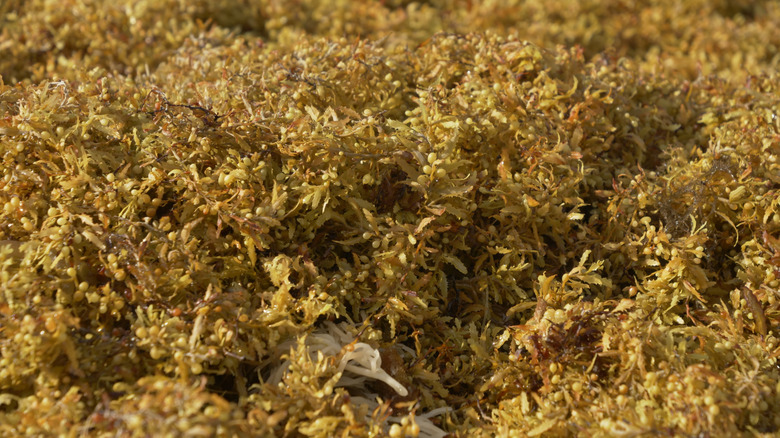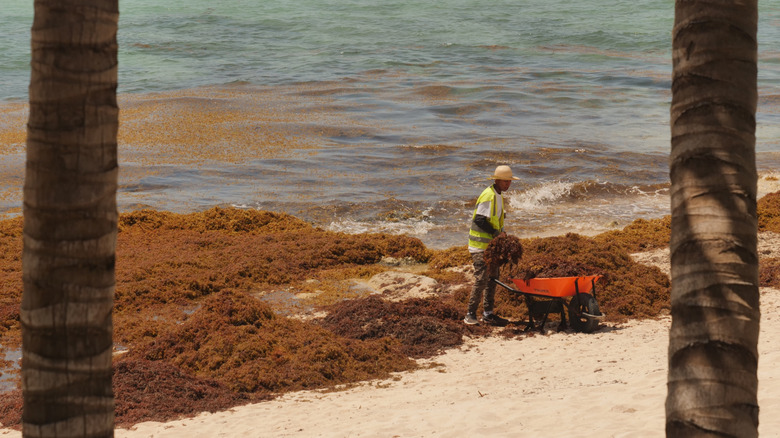What Is The Great Atlantic Sargassum Belt?
The Great Atlantic Sargassum Belt is an immense, recurring accumulation of brown macroalgae drifting across the tropical Atlantic Ocean. Composed of the floating seaweed Sargassum, this natural material has long been part of the ocean's ecosystem, providing food and shelter for various marine species. The word "Sargassum" actually originates from the Portuguese "Sargaço," meaning grape (as the sailors thought the seaweed looked like little grapes), and early explorers, such as Portuguese and Spanish sailors, gave the Sargasso Sea its name.
However, the phenomenon known as the Great Atlantic Sargassum Belt represents something far larger and more troubling. Stretching thousands of kilometers from the coast of West Africa to the Gulf of Mexico (it's so big it can be seen from space), this belt of seaweed has become a recurring event that affects coastlines across the Caribbean and the Americas. When it washes ashore and begins to decay, it releases toxic gases that pose a health risk to nearby communities. While Sargassum plays an important role in ocean ecology, its overabundance has become a growing environmental and public health concern.
Why are the algae blooming?
Floating Sargassum has been observed for centuries, famously encountered by early transatlantic sailors navigating the calm, weed-filled waters of the Sargasso Sea. Yet the Great Atlantic Sargassum Belt, as we know it today, has only been recognized within the past decade. In 2011, scientists using satellite data noticed unusually large and dense patches of Sargassum stretching across the Atlantic. This was a striking departure from historical patterns, which showed smaller, more localized blooms.
Researchers from the University of South Florida and NASA later confirmed that these massive aggregations had become a near-annual occurrence, forming a transoceanic belt that now appears almost every year. A 2019 study led by Mengqiu Wang and published in Science officially coined the term "The Great Atlantic Sargassum Belt," identifying it as the largest macroalgae bloom in the world.
Scientists attribute the rise of the Belt to a mix of natural processes and human influence. On one hand, shifting ocean currents, wind patterns, and nutrient-rich upwelling zones provide favorable conditions for Sargassum growth. On the other hand, human activities have accelerated their expansion. Increased nutrient runoff, particularly nitrogen and phosphorus from fertilizers, sewage, and deforestation, flows into the Atlantic via major rivers such as the Amazon and Orinoco. These great rivers are effectively fertilizing the ocean.
Climate-related changes – including waters that are warming 400% more than they were decades ago – and altered circulation patterns linked to the North Atlantic Oscillation, have also played a role by creating ideal conditions for rapid algal proliferation. Researchers from the University of South Florida recently identified a "tipping point" around 2010, when nutrient enrichment and climatic variability combined to spark the persistent, large-scale blooms now visible from space. The Great Atlantic Sargassum Belt, in this sense, reflects how human activity on land can profoundly reshape life in the sea.
The great Atlantic Sargassum Belt impacts communities
The impact of the Sargassum Belt on coastal communities has been both immediate and severe. As enormous mats of algae drift ashore, they begin to decompose, releasing gases such as hydrogen sulfide and ammonia, which can create a pungent "rotting egg" odor, the same that assaulted Florida beaches in the summer of 2025. These emissions are more than just unpleasant. They can irritate the skin, eyes, nose, and throat, cause headaches and nausea, and exacerbate respiratory conditions like asthma. In 2018, health authorities of Guadeloupe and Martinique reported over 11,000 medical consultations related to Sargassum exposure, and in 2023, similar air quality warnings were issued in several Caribbean islands as decaying algae produced unsafe concentrations of toxic gas.
Beyond health issues, the economic and social consequences are profound. Tourism, a lifeline for many Caribbean economies, suffers when beaches are blanketed with rotting seaweed. The algae clogs fishing nets, damages boat engines, and can even interfere with power plants and desalination facilities by obstructing water intakes. Environmentally, heavy Sargassum deposits smother coral reefs and seagrass beds, deplete oxygen levels, and leach heavy metals like arsenic into coastal waters, threatening marine biodiversity and food safety.
To address the growing problem, experts emphasize the need for coordinated action. Reducing the nutrient pollution that fuels these blooms is paramount. That means that local communities need to improve their agricultural practices and wastewater treatment. That would provide different management options to the increasing problems of Sargassum abundance. Enhanced monitoring systems, including satellite mapping by agencies like NASA and NOAA, can help predict where and when Sargassum will accumulate. This will give coastal communities time to organize and prepare.
Ultimately, the Great Atlantic Sargassum Belt stands as a warning, but also an opportunity. Research into sustainable uses for harvested Sargassum, such as biofuel production or agricultural applications, could turn a recurring hazard into a potential, unexpected energy source.


